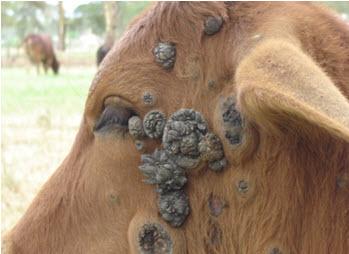Skin Tumours and Warts
 |
| Benign tumours |
|
© William Ayako, Kari Naivasha
|
All domestic animals can get skin tumours. Humans are not affected by skin tumours from animals. Some viruses e.g. the papilloma virus, may cause skin tumours.
There are two types of skin tumours: benign (warts) and malignant (skin cancer). Benign tumours are not life-threatening, do not spread to other areas of the body and either regress or are amenable to treatment and generally grow slowly. Malignant tumours can be life-threatening, grow quickly, can spread to other organs or tissues and may be difficult to treat.
In cattle, warts commonly are found on the head, neck and shoulders, and occasionally on the back and abdomen. One form appears on the teats in older animals. Warts appear about 2 months after exposure to the causal virus and may last for up to or longer than a year.
Apart from warts, the other most common skin tumour found in cattle is the Squamous Cell Carcinoma. This is a malignant tumour most commonly seen affecting the eye, the vulva or, less commonly, the back, of light skinned European breeds. It grows quickly, does not disappear but grows larger, smells, and requires urgent veterinary attention. If one of these is suspected do not wait, but call a vet. It will not go away!
Mode of spread of Warts
Spread is generally by direct contact with infected animals. Papillomatosis may become a herd problem when a large group of young susceptible cattle become infected. Most of these warts look like a cauliflower. Another type, which is flatter with a warty surface, may involve the venereal regions, where they can cause pain, disfigurement, infection of the penis of young bulls and difficulty in calving when the vaginal mucosa of heifers is affected.
Immunity after recovery is solid and persists for at least 2 years. The lack of susceptibility of adults to natural infection is thought to be due to immunity acquired by apparent or unapparent infection when young.
Signs of Skin Tumours
- Hard lumps on the skin that are not hot are often tumours. These lumps may grow slowly, in which case they may be benign. If they grow fast they are probably malignant. Sometimes the skin over a tumour is injured and the lump has open sores on it. If this is the case the tumour is most probably malignant. It is better to get a professional to examine it early than to wait until it is too late to do anything about it.
Horses, mules and donkeys sometimes get skin tumours called Sarcoids. These are the most frequently recognized tumours of horses. A virus, probably the bovine papilloma virus, is suspected. They can be transmitted by direct or indirect contact or by insects. They can grow anywhere on the body but the base of the ear, on the penis, around the eyes and low on the legs are favoured sites. They do not normally spread through the body but they often grow back if they are surgically removed. Treatments are available.
Young horses often get small scattered papillomas on the nose, lips, eyelids, lower legs, penis, vulva, mammary glands and inner surface of the ears, often following mild scratches. They can be a herd problem especially when young horses are run together, but regress in a few months as the foal's immune system matures. When they develop in older horses they can persist for more than a year.
Camels about a year old can get small skin tumours around the lips and nose. Older camels sometimes get tumours, especially on the teats. The tumors disappear on their own after a few months.
Prevention - Control - Treatment
- There is no known treatment for most tumours. Some tumours do not spread to other parts of the body (these are the benign tumours). Skilled veterinarians sometimes remove benign tumours. Some tumours spread to other parts of the body (these are the malignant tumours). It is not worth operating to remove these because they come back in other parts of the body.
- Infectious papillomatosis disappears on its own, although the duration of warts varies considerably. A variety of treatments has been advocated without agreement on efficacy. Surgical removal by a vet is recommended if the warts are sufficiently objectionable. However, because surgery in the early growing stage of warts may lead to recurrence and stimulation of growth they should be removed when near their maximum size.
- Affected animals may be isolated from others likely to be infected, but with the long incubation period many are likely to have been exposed before the problem is recognized.
- Vaccines are of some value for prevention but are of little value in treating cattle that already have lesions. Because wart viruses are mostly species specific there is no merit in using a vaccine derived from one species in another.
- When the disease is a herd problem it can be controlled by vaccination with a suspension of ground up wart tissue in which the virus has been killed by formalin. An autogenous vaccine i.e. one derived from animals in the affected herd, may be more effective than a commercial one.
- The best action is to do nothing yourself, but call a veterinarian to assess the problem. Trying to treat a tumour without knowing its type may lead to disaster! Leave well alone and call a vet.
